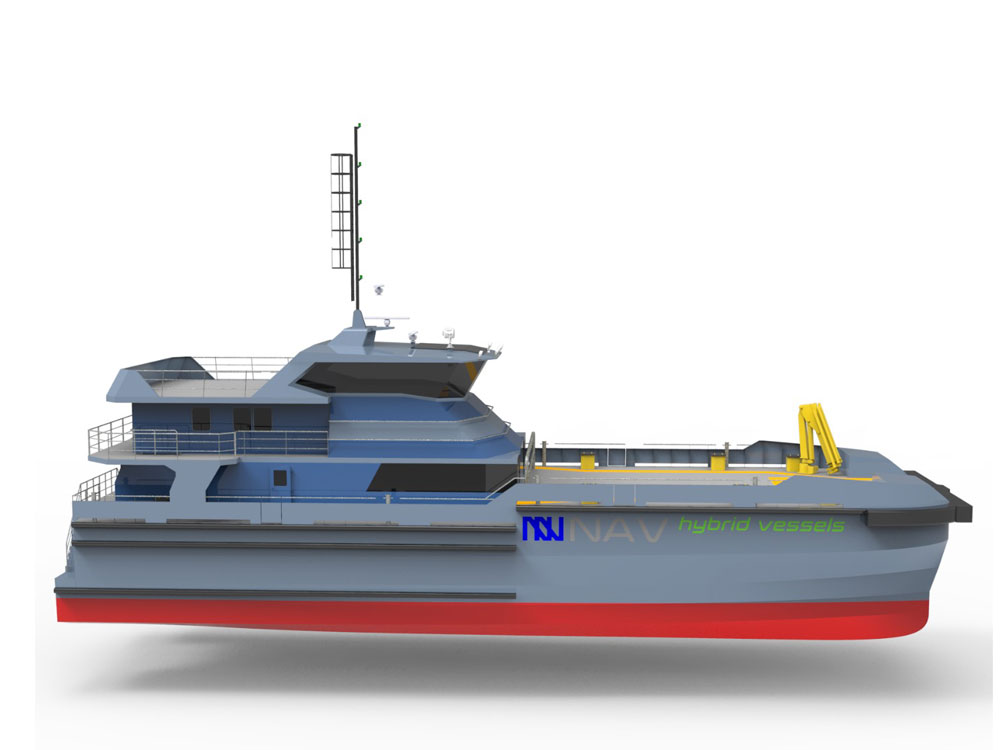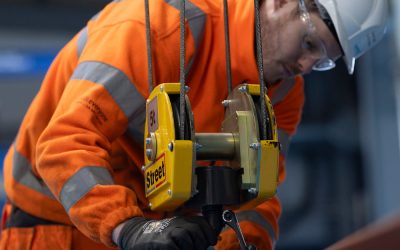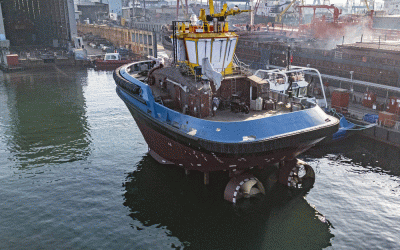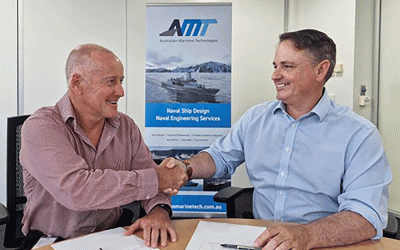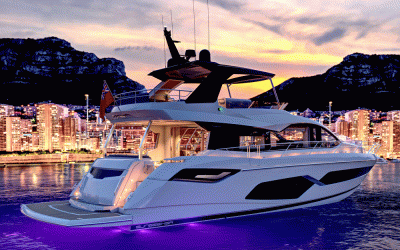A year on from the launch of its first 26m crew transfer vessel (CTV) concept, NAV Engineering & Technology has unveiled plans for a larger, 35m variant. But why go bigger on a proven design, and what’s in it for offshore operators?
Formed last year as a subsidiary of Newport Shipping, NAV’s first offering was the HybriNav26 design (see Ship & Boat International November/December 2023, pages 42-45): a 26m x 9.2m CTV with waterjet propulsion, aimed at the European offshore wind sector. In turn, the new 35m x 11m HybriNav35 concept has been developed following testing, market observations and end user feedback.
“From a charterer’s perspective, smaller CTVs are really good at going out in the morning, putting technicians onto the turbines or service operation vessels [SOVs], then going back in the evening,” says Kris Benne, NAV manager for offshore wind. “However, the current generation of wind farms is located further out offshore. Transfer times are getting too long and uncomfortable for daily transits to the site, especially during the operations phase following construction. It’s not feasible if you’re stuck on a boat for five to six hours a day.”
Hence the offshore renewable energy sector’s reliance on SOVs, which remain on site and provide berths for crew. These vessels, typically sized 70-80m, can be expensive to operate and maintain, however. Also, SOV day rates are on an upward trajectory, fuelled by strong demand for available vessels and a limited supply of SOVs. Edda Wind, for instance, has predicted that SOV and commissioning SOV (CSOV) day rates may increase from the €35,000 recorded in 2023 to €44,000 by Q4 2026.
The logical way forward, then, would be for operators to share SOVs between sites: if there is not enough money for each wind farm to have its own dedicated SOV, why not use one SOV to serve multiple wind farms at the same time? The problem there, Benne points out, is that “the sites’ effective owners may be different banks or pension funds; Wind Farm A might be owned 50% by Pension Fund UK, while Wind Farm B might be owned 50% by Pension Fund Netherlands”. Naturally, this presents scope for conflicts of interest.
“For example, Wind Farm A may be located 60km away from Wind Farm B,” Benne continues. “If something goes wrong at Wind Farm A – say, a turbine breaks down or there is an outage somewhere – and the SOV is currently at Wind Farm B, the owner of Wind Farm A will tell the SOV operator, ‘I don’t care – you promised me logistics, you promised me a certain uptime – I want that SOV back here right now!’. And, Wind Farm B will say, ‘I don’t care what happens at Wind Farm A: I’m only invested in Wind Farm B and I need that vessel here, doing my maintenance’.”
While SOVs carry daughter craft to enable technician and cargo transfers, these small boats are impractical for travelling distances such as 60-70km, Benne says, adding: “This is where our 35m CTV comes in – it can do everything a normal CTV can do, but is big enough to stay out offshore for up to two weeks, comfortably; it doesn’t need to return to base every time there’s a storm with significant wave heights of 2m.
“We realised we needed this vessel length to accommodate everything required for extended operations offshore and crew comfort. The new size enables offshore wind farm operators to say, ‘I have an SOV that only goes from turbines 1-100 in a very planned manner throughout the season, and which doesn’t do anything else: it doesn’t deviate from course or go to another wind farm. But this fast CTV can take whatever comes up around it – it can do inspections and transfer turbine or substation technician teams to far-away wind farms, stay there until they’re done, then bring them back to the SOV to sleep’.”
In this way, the CTV would guarantee swift cargo transfers and an instant response to any required troubleshooting or minor work. However, Benne is keen to stress that the 35m CTV should not be confused with the emerging mini-SOV (or ‘midi-sized’ SOV) concept that has been mooted by some naval architects and designers over the past 12 months or so. “In comparison to the current trend towards mini-SOVs, we believe that the gap in performance is negligible when compared to operational costs and the reach of our design in combination with a more standard SOV,” he says.
The HybriNav35 can transfer a maximum of 30 technicians, with the standard configuration supporting 24 seats. The new vessel’s increased deck area, plus the addition of a dedicated drone area, should allow for a wide range of operations beyond traditional cargo transport, Benne adds.
(For the full article and technical particulars, check out Ship & Boat International July/August 2024)
